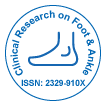当社グループは 3,000 以上の世界的なカンファレンスシリーズ 米国、ヨーロッパ、世界中で毎年イベントが開催されます。 1,000 のより科学的な学会からの支援を受けたアジア および 700 以上の オープン アクセスを発行ジャーナルには 50,000 人以上の著名人が掲載されており、科学者が編集委員として名高い
。オープンアクセスジャーナルはより多くの読者と引用を獲得
700 ジャーナル と 15,000,000 人の読者 各ジャーナルは 25,000 人以上の読者を獲得
インデックス付き
- Google スカラー
- シェルパ・ロミオ
- Jゲートを開く
- アカデミックキー
- レフシーク
- ハムダード大学
- エブスコ アリゾナ州
- OCLC-WorldCat
- パブロン
- ジュネーブ医学教育研究財団
- ユーロパブ
- ICMJE
役立つリンク
オープンアクセスジャーナル
このページをシェアする
抽象的な
Functional Competency of the Foot and Ankle in Older People
Kara Daniel
Background
There are structural and functional changes in the foot and ankle as people age, and there is tentative evidence that foot issues affect balance and raise the risk of falling. We conducted a study to ascertain the relative contributions of various foot and ankle traits on performance on a variety of balance and functional tests in order to further examine this.
Methods
The foot and ankle characteristics, sensorimotor function, balance, and functional ability of 176 residents of a retirement community (56 men and 120 women, mean age 80.1 years, standard deviation 6.4 years) were tested. The foot and ankle characteristics included foot posture, range of motion, strength, and deformity (including tests of standing balance, leaning balance, stepping, sit-to-stand, and walking speed).
Results
In univariate analysis, a variety of foot and ankle traits as well as sensorimotor measurements were linked to success on the balance and functional tests. Ankle flexibility, plantar tactile sensitivity, and toe plantarflexor strength were repeatedly found through multiple regression analysis to be significant and independent predictors of balance and functional test performance, accounting for up to 59% of the variance in these test results.
Conclusions
Foot and ankle features, in particular ankle flexibility, plantar tactile sensitivity, and toe plantarflexor muscle strength, are significant independent predictors of balance and functional ability in older people. People may be able to move more freely and decrease their risk of falling if their plantar sensitivity is improved and their foot's flexibility and strength are increased.

 English
English  Spanish
Spanish  Chinese
Chinese  Russian
Russian  German
German  French
French  Portuguese
Portuguese  Hindi
Hindi